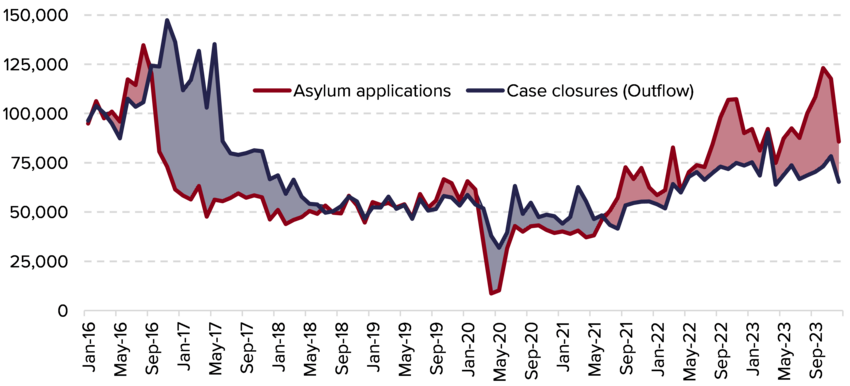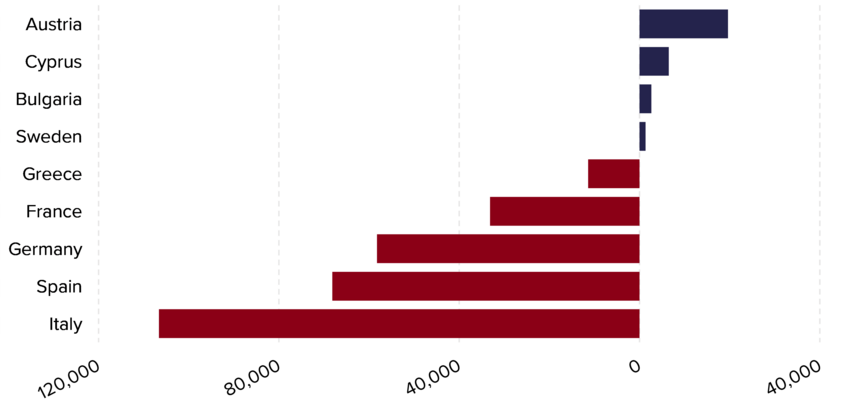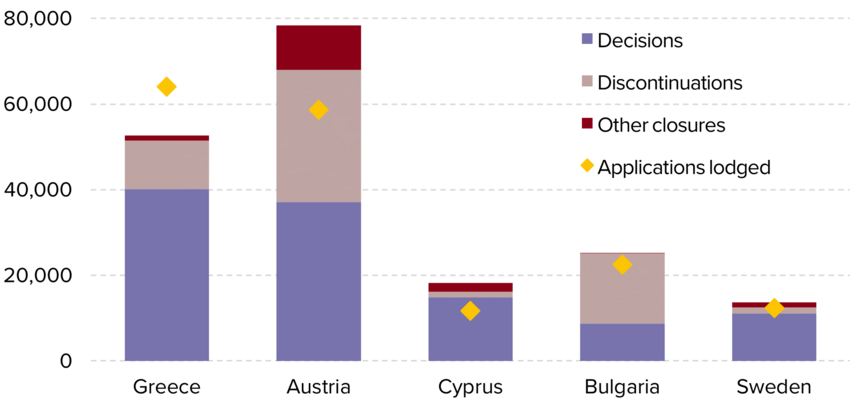3.4.8.1. Case closures in relation to the number of asylum applications
In 2023, EU+ countries issued about 677,000 first instance decisions, the most since 2017. However, decisions on asylum applications are just one way to close an asylum case. Discontinuations and other case closures also contribute towards the overall outflow at first instance. In 2023, the overall number of cases exiting the asylum system at first instance (combining first instance decisions, discontinuations after withdrawals and other closures) also reached the highest level in 6 years (at about 863,000).
To accurately depict the level of pressure on national asylum systems, the number of applications lodged (inflow) should be juxtaposed with all case closures (outflow). This reveals that the gap between the inflow of applications for international protection and the outflow of cases exiting the asylum system at first instance continued to widen to be the largest in 5 years. In other words, in 2023, the asylum system at first instance absorbed approximately 280,000 cases more than it managed to process. This marked a caseload accumulation increase by 66% from 2022, which contributed to the continuation of the trend visible since mid-2021 whereby the inflow consistently exceeded the outflow (see Figure 12).
Growing gap between applications received and case closures
Figure 12. Applications and case closures (first instance decisions, discontinuations after withdrawals and otherwise closed cases) in EU+ countries, January 2016–December 2023

Note: Data were not available for Portugal for October-December 2023.
Source: EUAA EPS data as of 1 February 2024.
Italy and Spain – where the first instance decision-making output declined the most in absolute terms in 2023 – were also the countries with the largest gaps between the inflow and processed cases at first instance (see Figure 13), i.e. they received significantly more applications than they managed to process. Other countries with much higher inflows than outflows were Germany and France (in descending order), both consistently among the main receiving countries of asylum applications in the EU+.
Figure 13. Disparity between inflow and outflow at first instance in EU+ countries with the largest gaps, 2023

Source: EUAA EPS data as of 1 February 2024.
At the other end of the spectrum, Austria, followed at a distance by Cyprus, Bulgaria and Sweden (in descending order), closed more cases at first instance than applications received. However, only Cyprus and Sweden did so primarily because of decisions issued at first instance (see Figure 14). In Austria, two-fifths of case closures pertained to discontinuations due to implicit withdrawals, and in Bulgaria, implicit withdrawals accounted for two-thirds of case closures. In both cases, this was related to onward movements within EU+ countries. Furthermore, in Austria, Cyprus and Sweden, otherwise closed cases – mostly in Dublin procedures – accounted for roughly one-tenth of all case closures.
Figure 14. Case closures by type (first instance decisions, discontinuations after withdrawals and otherwise closed cases) and number of asylum applications lodged in selected EU+ countries, 2023

Source: EUAA EPS data as of 1 February 2024.

